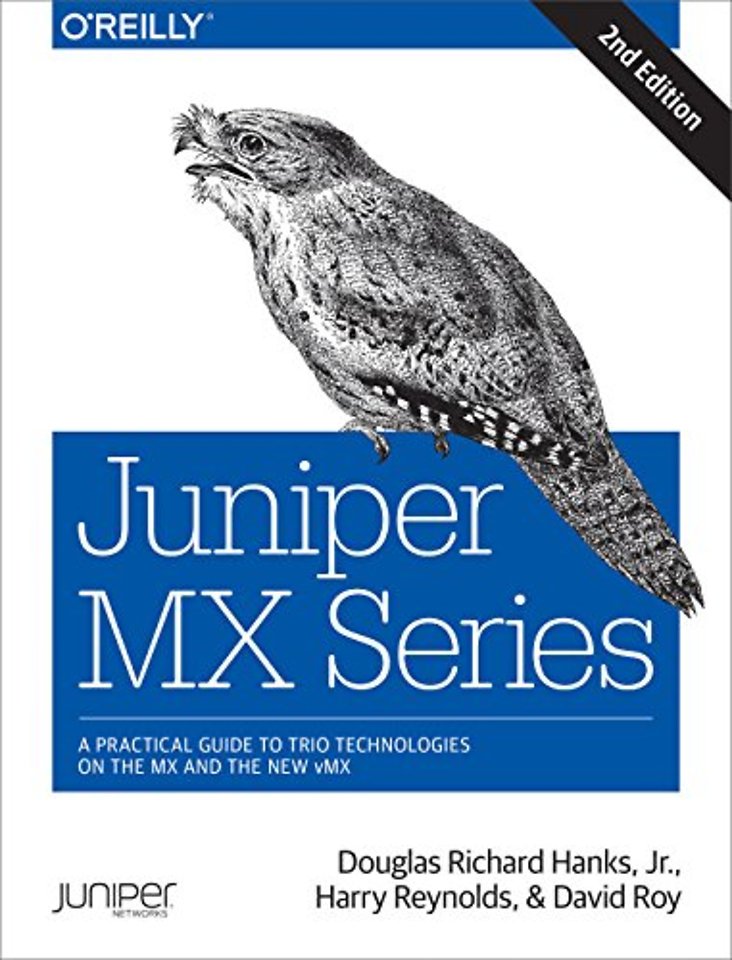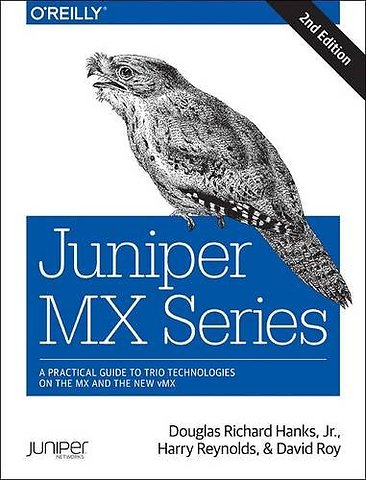


Douglas Richard Hanks Jr. is a Data Center Architect with Juniper Networks and focuses on solution architecture.
Meer over de auteursJuniper MX Series
A Practical Guide to Trio Technologies on the MX and the New VMX
Samenvatting
Discover why routers in the Juniper MX Series—with their advanced feature sets and record-breaking scale—are so popular among enterprises and network service providers. This revised and expanded edition shows you step-by-step how to implement high-density, high-speed Layer 2 and Layer 3 Ethernet services, using advanced firewall filters, redundant inline services, powerful CoS tool sets, and many other Juniper MX features.
This second edition was written by a Senior NOC Engineer, whose vast experience with the MX Series is well documented. Each chapter covers a specific Juniper MX vertical and includes review questions to help you test what you’ve learned. This edition includes new chapters on load balancing and vMX—Juniper MX’s virtual instance.
-Discover Junos architecture, MX chassis, and Trio Linecards
-Work with Juniper MX’s bridging, VLAN VXLAN, and virtual switches
-Create a firewall filter framework and discover the latest flexible filtering options
-Secure your router and add an extra layer of security with Junos DDOS protection and SCFD feature
-Discover the advantages of hierarchical scheduling, ingress queuing, and flexible remarking
-Combine Juniper MX routers, using a virtual chassis or MC-LAG
-Understand and use classical and advanced Trio Chipset’s load balancing features
-Dive into Trio inline services such as inline NAT, redundant logical tunnel, or filter-based GRE tunnel
-Discover vMX internal architecture and explore the benefits and typical use case of a virtual router
Specificaties
Over Harry Reynolds
Inhoudsopgave
1. Juniper MX Architecture
-Junos
-Juniper MX Chassis
-Trio
-Line Cards and Modules
-Switch and Control Board
-Summary
-Chapter Review Questions
-Chapter Review Answers
2. Bridging, VLAN Mapping, IRB, and Virtual Switches
-Isn't the MX a Router?
-Layer 2 Networking
-Junos Interfaces
-Interface Bridge Configuration
-Service Provider Interface Bridge Configuration
-Enterprise Interface Bridge Configuration
-Service Provider VLAN Mapping
-Bridge Domains
-Integrated Routing and Bridging
-Virtual Switch
-VXLAN
-Summary
-Chapter Review Questions
-Chapter Review Answers
3. Stateless Filters, Hierarchical Policing, and Tri-Color Marking
-Firewall Filter and Policer Overview
-Filter Operation
-Policing
-Applying Filters and Policers
-Advanced Filtering Features
-Bridge Filtering Case Study
-Service Provider DDOS Filtering Case Study
-Summary
-Chapter Review Questions
-Chapter Review Answers
4. Routing Engine Protection and DDoS Prevention
-RE Protection Case Study
-DDoS Protection Case Study
-DDoS Case Study
-Suspicious Control Flow Detection
-Mitigate DDoS Attacks
-BGP Flow-Specification Case Study
-Summary
-Chapter Review Questions
-Chapter Review Answers
5. Trio Class of Service
-MX CoS Capabilities
-Trio CoS Flow
-Hierarchical CoS
-Per-VLAN Queuing for Non-Queuing MPCs
-Trio Scheduling and Queuing
-MX Trio CoS Defaults
-Flexible Packet Rewrite
-Predicting Queue Throughput
-CoS Lab
-Add H-CoS for Subscriber Access
-Chapter Review Questions
-Chapter Review Answers
6. MX Virtual Chassis
-What is Virtual Chassis?
-MX-VC Configuration
-VCP Interface Class of Service
-Summary
-Chapter Review Questions
-Chapter Review Answers
7. Trio Load Balancing
-Junos Load Balancing Overview
-Trio Load Balancing and Backward Compatibility
-Advanced Load Balancing
-Summary
-Chapter Review Questions
-Chapter Review Answers
8. Trio Inline Services
-What are Trio Inline Services?
-J-Flow
-Network Address Translation
-Tunnel Services
-Port Mirroring
-Layer 2 Analyzer
-Summary
-Chapter Review Questions
-Chapter Review Answers
9. Multi-Chassis Link Aggregation
-Multi-Chassis Link Aggregation
-Inter-Chassis Control Protocol
-MC-LAG Modes
-Case Study
-Summary
-Chapter Review Questions
-Chapter Review Answers
10. Junos High Availability on MX Routers
-Junos High-Availability Feature Overview
-Graceful Routing Engine Switchover
-Graceful Restart
-Nonstop Routing and Bridging
-In-Service Software Upgrades
-ISSU Lab
-Summary
-Chapter Review Questions
-Chapter Review Answers
11. The Virtual MX
-Why Use vMX and for What Purpose?
-A Technical Overview of vMX
-vMX and the Virtual World
-Resources for Installing vMX for Lab Simulation
-Technical Details of the vMX
-Summary
-Chapter Review Questions
-Chapter Review Answers
Index
Anderen die dit boek kochten, kochten ook
Net verschenen
Rubrieken
- aanbestedingsrecht
- aansprakelijkheids- en verzekeringsrecht
- accountancy
- algemeen juridisch
- arbeidsrecht
- bank- en effectenrecht
- bestuursrecht
- bouwrecht
- burgerlijk recht en procesrecht
- europees-internationaal recht
- fiscaal recht
- gezondheidsrecht
- insolventierecht
- intellectuele eigendom en ict-recht
- management
- mens en maatschappij
- milieu- en omgevingsrecht
- notarieel recht
- ondernemingsrecht
- pensioenrecht
- personen- en familierecht
- sociale zekerheidsrecht
- staatsrecht
- strafrecht en criminologie
- vastgoed- en huurrecht
- vreemdelingenrecht





